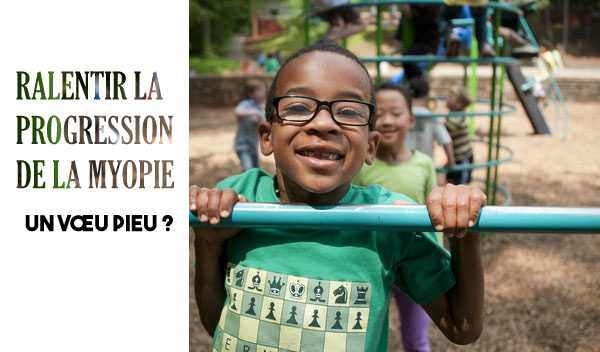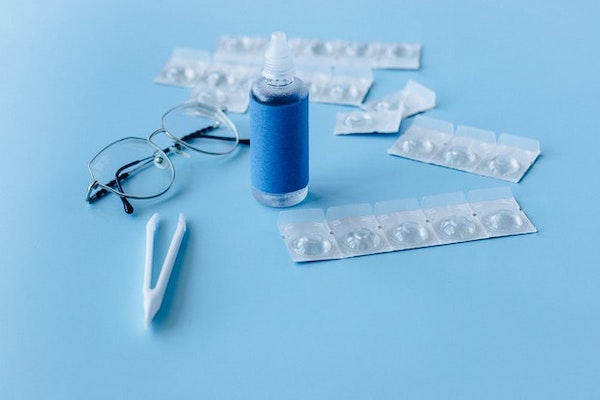REPORT Slowing down the progression of myopia: wishful thinking?

The progression of myopia seems to have no end. The problem, often associated with a Western way of life that gives pride of place to screen work, is in fact of a global nature. Despite many efforts, and research that focuses on the best ways to curb it, myopia still seems to be gaining ground. As digital objects continue to develop and access to care becomes easier, is wanting to slow the progression of myopia akin to wishful thinking? Like climate change, shouldn't we better prioritize adaptation over prevention?
The alarming figures of myopia: a real "epidemic"
For more than ten years, the figures have taken a crazy turn. In 2012, a professor from the University of Singapore revealed that 78% of 15-year-old Chinese were nearsighted! In Australian high schools, we are talking about 80 to 90% of students. In the United States and Europe, the rate of myopia has doubled compared to the 1970s. How is it that this progression is so dazzling? For Professor Gilles Renard, scientific director of the French Society of Ophthalmology, the explanation is all found. “The major centers of myopia are concentrated first within the civilizations which have developed writing. It requires a lot of near vision. And today, more and more, children and young people are affected because of the use of screens.”
For Ian Morgan, researcher at the University of Canberra , soliciting near vision most of the time forces accommodation. However, the latter tires the eyes and promotes myopia. Indeed, looking at objects up close (books, screens, etc.) “forces our eyes to strain”. A lifestyle that emphasizes being outdoors prevents this. As a bonus, under the rays of the sun, the retina releases dopamine , a chemical messenger with a crucial role in the transmission of images to the brain. For lack of dopamine, the eye enlarges and also promotes myopia. This explains why it develops strongly in adolescents.
Is it actually possible to slow down myopia?
We can ask ourselves a question. While we adapt to living with myopia thanks to optical devices, why should we slow down its progression at all costs? First of all because access to optical care is not strictly speaking something "easy" depending on where you are. In some parts of the world, being able to control and correct is like an obstacle course. And even in our Western countries where access to care is easier, it can be complicated. Particularly in view of the delays practiced in ophthalmology .
On the other hand, myopia causes many ocular complications , such as cataracts, risks of retinal detachment, glaucoma, maculopathies… Slowing down the progression is therefore a matter of public health. In a society where we can hardly do without our computers, tablets, smartphones or televisions, the scale of the task seems considerable.
One thing is certain: myopia does not cannot be stopped. But can it be slowed down? Many studies have been conducted on the subject. Avenues have been proposed, such as the adaptation of rigid lenses, the prescription of progressive or bifocal lenses, the interest of bifocal lenses or even orthokeratology .

But among all these avenues, rigid lenses turned out to be a false good idea because they do not slow down the elongation of the eyeball in the youngest. The purpose of progressive lenses is to compensate for the insufficient accommodation of young myopes. But in this specific case, if a slowdown has been observed, it is insignificant and does not turn out to be a good lead.
Orthokeratology is a technique for the medical correction of myopia, which consists of wearing rigid lenses at night, to induce a temporary correction of myopia, the expected duration of which covers the following day. It allows a change in shape of the cornea by flattening it. This technique is effective but for so-called low myopia. Bifocal lenses, they can slow the progression of myopia in patients over forty years.
But concerning the youngest, if we tend to encourage reading , we must not forget that the essential element during the growth phase is to spend as much time as possible outside…easier said than done!
[= ]
Adapt rather than prevent?
While these various studies have not offered the hoped-for solutions, some manufacturers have made significant progress in slowing down myopia. Thus, Essilor's Stellest lenses have, beyond very fine promises, obtained very convincing results. As reported by a study in the prestigious journal JAMA Ophthalmology (Journal of the American Medical Association), after two years of wearing, the slowing down of myopia in young children is significant. According to the famous glassmaker, wearing the device twelve hours a day slows the progression of myopia by 67% compared to other single vision lenses.
For the doctor Jinhua Bao, Director of the Myopia and Visual Function Laboratory, "These impressive results clearly demonstrate that the use of HAL (highly aspherical) lenses, instead of single vision lenses for myopia correction, would be a strategic approach for slow the progression of myopia in children. A study that also shows that the longer the myopia control solution is worn, the more effective it is."
https: //www.youtube.com/watch?v=qVz0SwRAReQ&ab_channel=EssilorFRANCE
These very good results are proof that a slowdown is possible. Finally, it therefore seems that it is adaptation that is privileged, not prevention. However, one does not go without the other. If it seems complicated to spend all your time outside with your children and until the end of their growth so that they are not subject to the pangs of myopia, the devices will make it possible to slow down an undeniable progression. But, in order not to fall into fatalism, we can also question lifestyles that favor the use, often superfluous, of smartphones by young children, provoking mistrust of the outside world which has social and indisputable health.
Of course, screens are not the only cause. The fact that a child spends seven hours a day in class staring at a piece of paper or a board does not help. This is also why the proportion of myopes will constantly increase. Here again, a reassessment can be beneficial. But it must be recognized that, for valid reasons, in any society, change is often very complicated.
Sources: Essentiel de l'Optique, https://sante. lefigaro.fr , Doctor Damien Gatinel https://www.gatinel.com/


